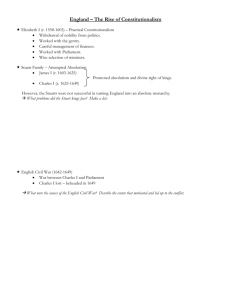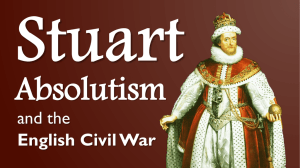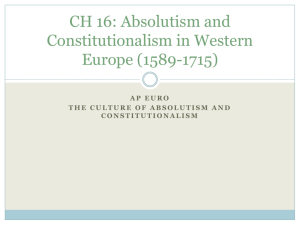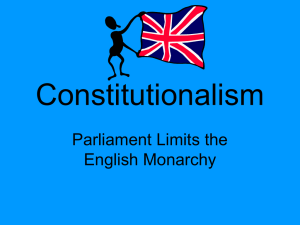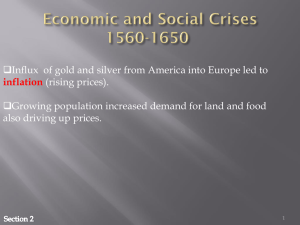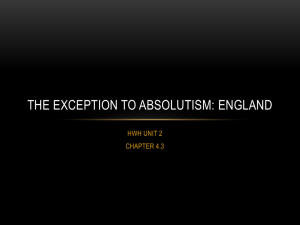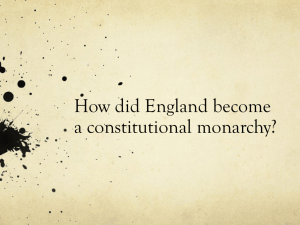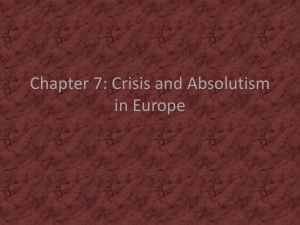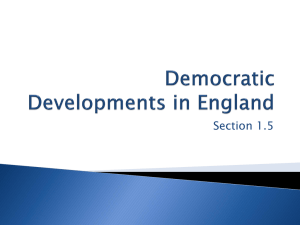Chapter 13 Constitutionalism & Absolutism Part I England
advertisement
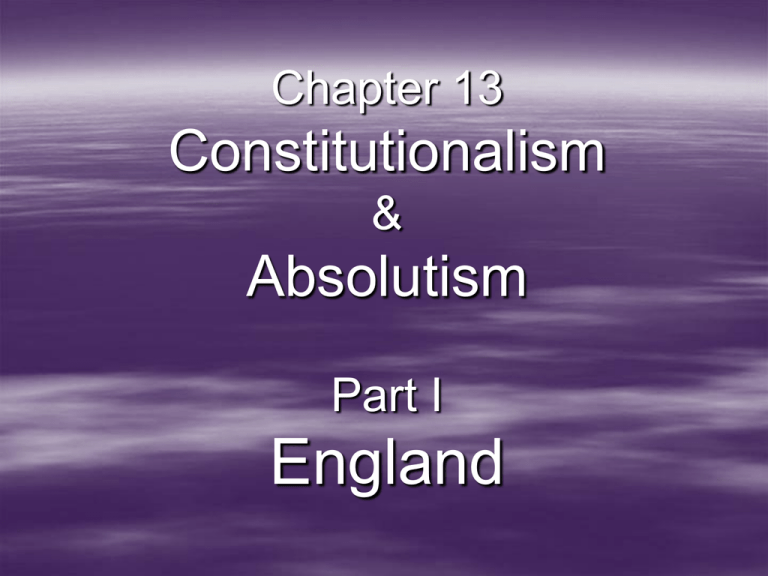
Chapter 13 Constitutionalism & Absolutism Part I England Who am I? I was from Scotland and succeeded Elizabeth I as King of England I reigned from 1603 to 1625 Hint: a Virginia colony was named for me James I Who am I? I conquered Ireland and Scotland I “rumped” Parliament I stirred up a lot of trouble for those darn Anglicans All I wanted was a “Pure-itan Republic” Lord Protector Oliver Cromwell I don’t like the English I don’t like Protestants I wanna be an absolute king and do things MY way I freaked out the Tories I’d rather spend my time brushing my hair Who am I? James II I’m really NOT Capt. Hook! I ruled from 1660-1685 I renewed the Navigation Acts I fought with the Dutch I was buddies with Louis XIV (he even gave me £££) Charles II My daddy was James I I had a tough time deciding on how to use Parliament, finally I decided I really didn’t need it—that’s the long and the short of it. Who am I? Charles I ‘Til death us do part We had a “glorious reign” We even created a Bill of Rights We ruled from 1689 to 1702 William and Mary This system does not require a written constitution Constitutionalism This system does require a set of rules about government that government respects. Constitutionalism This system implies a balance in power between government and its subjects. Constitutionalism What I do on a Saturday night! Hey, I needed another slide! Stay home and make up Jeopardy games! What will you do tonight that you should have done last week? Hi Sam? Yeah, its me. I got a question: who was that king that had the big hair? No, not the woman, the guy, you know…? The one who looked like Captain Hook? Oh right. What did he do again? So, how ‘bout those Denver Broncos!? Study for this TEST! This system means that sovereignty resides exclusively with the monarch. Absolutism This system represents a change from medieval reality of the feudal system. Absolutism This means that the monarch was limited in actual power and not totalitarian. He/she didn’t involve him/herself in social welfare issues (not that there really were any). Absolutism This petition forbade forced loans without the consent of Parliament. Petition of Right After dissolving Parliament in 1629, why did Charles I not call it again until 1640? England went to war against Scotland This was Charles I’s attempt at strict efficiency and administrative centralization. The policy of “thorough” This refers to the Parliament called after the Scottish invasion in 1640 The LONG Parliament This Parliament resolved that Parliament could not be dissolved without its own consent. The LONG Parliament The major accomplishment of this Parliament was a declaration of political and religious rights against the royal government. The LONG Parliament This was a 200 article summary of parliamentary grievances against the crown. Grand Remonstrance During the English Civil War, this group supported Parliament. Roundheads My head is round— watch me bounce!! During the English Civil War this group supported Charles I. Cavaliers This code was a set of laws which excluded Roman Catholics, Presbyterians, and Independents from the political life of the nation. Clarendon Code These Acts led to a series of naval wars with Holland (innies/outies) Navigation Acts This king’s domestic policy goal was to subject English institutions to the power of the monarchy. James II This act of 1672 required all subjects to swear an oath against transubstantiation, and was passed by Parliament. Test Act This act of 1701 provided for the English crown to go to the House of Hanover if Queen Anne was not survived by her children. The Act of Settlement 1701 This plot was the hysteria surrounding a supposed attempt to execute Charles II The Popish Plot This treaty required Charles II to convert to Catholicism as soon as conditions in England permitted. Treaty of Dover, 1670 We are a group who is very loyal to the monarchy. Tories Photo Op C or A Policies Other Stuff Guys & Groups 100 100 100 100 100 200 200 200 200 200 300 300 300 300 300 400 400 400 400 400 500 500 500 500 500 600 600 600 600 600

